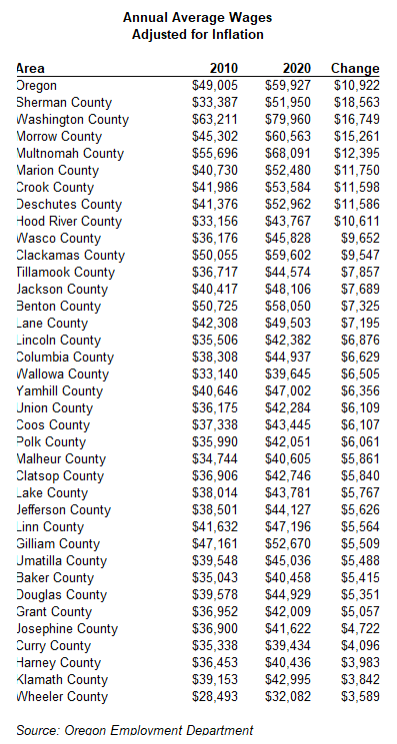Inflation-Adjusted Wages Rose in All Oregon Counties Since 2010
By Erik Knoder
Oregon Employment Department Regional Economist
Clatsop, Columbia, Lincoln, and Tillamook counties

Although wages are increasing in 2021, inflation is increasing more rapidly for many workers. Inflation adjusted average wages have started to fall slightly but it’s hard to tell if this will be a long-term trend. All of Oregon’s counties saw an increase in inflation-adjusted average wages from 2010 to 2020. Overall, the average wage for the entire state increased by $10,922 over those 10 years after adjusting for inflation. Most of the statewide increase was driven by the large gains in Washington and Multnomah counties. These two counties in the Portland metro area are home to more than 1.4 million Oregonians (about one-third of the state’s population) and more than $55 billion in payroll (slightly over 50% of the state’s total). Washington County is home to several high-wage industries, including company headquarters and high-tech manufacturing. Both of these industries have a disproportionately large presence in the county, and the county has added thousands of jobs over the past 10 years.
A second important reason for the large increase in average wages is the loss of lower-wage jobs during the pandemic recession. The leisure and hospitality industry had an average wage of just $24,329 in 2020 – by far the lowest of any industry. Leisure and hospitality also lost more than 51,000 jobs in 2020. The massive loss of low-wage jobs caused the average wage calculated for the remaining jobs to increase in a possibly misleading way. Although wages have been increasing for many individual jobs, they probably haven’t increased as much as the averages suggest.
The table below shows the 2020 annual average wage by county in Oregon and the 2010 annual average wage after adjusting for inflation by the Consumer Price Index for urban consumers. The wages are for workers covered by unemployment insurance, which excludes self-employed workers and a few others such as real estate brokers who are paid by commission.
A couple of the top-gaining counties on a per-person basis are located in the Columbia Gorge. Sherman and Morrow counties benefited from the expansion of construction and new manufacturing businesses and their associated professional jobs.
The counties with less growth in wages are often smaller and rural. Wheeler County had essentially no growth in private-sector employment from 2010 to 2020. Klamath County added jobs overall but lost jobs in manufacturing, finance, and professional and business services. Harney County lost very few of its leisure and hospitality jobs in 2020, thereby maintaining a more representative change in its average wage, but also moving toward the bottom of the rankings.
It remains to be seen how overheated inflation in the 2021 pandemic recovery will affect workers’ real wage growth over time. Employers are recovering more of their lower-wage positions, which could drive average wages down. However, competition for available workers has also heated up and driven up starting wages.


Advertisement